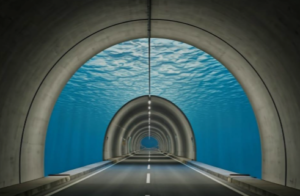Transatlantic Tunnel: Travel from New York to London in just one hour
Transatlantic Tunnel: Travel from New York to London in just one hour

Channel Tunnel built under the sea of the English Channel:
Transatlantic Tunnel:
Imagine how it is possible to travel from New York to London by air in just one hour, where it takes more than seven hours? The proposed £15 trillion transatlantic tunnel could open the door to that possibility. The tunnel will allow passengers to reach London from New York in just 54 minutes at a speed of 3,000 miles per hour.
The ambitious proposal to build a trans-Atlantic tunnel connecting New York and London has been around for a long time, and has recently been the subject of online discussions. According to the UK-based news outlet Metro, it is an attractive idea, but the cost is prohibitive. The estimated cost of the 3,400-mile tunnel is £15 trillion, or $19.4 trillion. The complexity and size of the project means it will take decades.

The Channel Tunnel, which previously ran 23.5 miles under the English Channel, connected Folkestone in the UK and Coquelles in France. It took six years to build. The trans-Atlantic tunnel would take much longer.
According to the Metro, recent developments in technology, from vacuum tube technology and pressurized vehicles, could make this a reality. The proposed trains would travel through pressurized tunnels, where they would be able to reach speeds of up to 3,000 miles per hour without air resistance. If the project’s ideas ultimately go ahead, it would be like Londoners being able to cross the pond in just an hour on a New York train.
The Metro says it could be environmentally friendly and reduce the heavy air pollution caused by air travel. The technology is similar to the Superloop train, which Swiss engineers have tested and claim could change the ‘future of travel’.
Some engineers have suggested building the proposed transatlantic tunnel through thick seabed, while others believe it would be better to suspend it by cables or stilts. The Channel Tunnel reaches only 245 feet below the surface, but the proposed transatlantic tunnel could go much deeper.
The idea of an underwater tunnel emerged in the 19th century. In 1802, French mining engineer Albert Mathieu-Favier proposed a concept for a tunnel between France and England, which would be lit by oil lamps.

Many different technologies have been proposed for a trans-Atlantic tunnel. However, challenges related to its scale, cost, and practicality have prevented progress. However, recent advances in vacuum tube technology have significantly increased the feasibility of the trans-Atlantic tunnel concept.
Transatlantic Tunnel: The concept of a vacuum-powered train was popularized by Elon Musk. He published a paper in 2013 proposing the use of a vacuum environment to reduce air resistance, increase efficiency and speed. Since then, Hyperloop technology has gained significant attention. It is being trialed in countries such as India and China. There are plans to include it in national high-speed rail networks.





